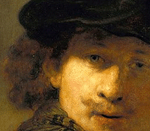
"Parable of the Labourers in the Vineyard"
Rembrandt was a Dutch painter who is generally considered one of the greatest painters and printmakers in European art history. Although he is known for his portraits, Rembrandt’s greatest artistic accomplishments are his historical and religious scenes. Rembrandt created many paintings and etchings of Biblical scenes. Some of his most famous works depicting Biblical scenes include “The Raising of the Cross” and “The Return of the Prodigal Son”. Though Rembrandt did not intend to paint religious scenes for the sake of promoting religious views, his paintings reflect his own personal beliefs. In his day, Rembrandt was a devoted Protestant who believed strongly in God’s covenant. Later works depict religious scenes depicting Christians meditating or praying.
This painting is a work emblematic of the Baroque art movement, characterized by its dramatic use of light and shadow, vivid realism, and emotional intensity. The genre of the artwork is religious, as it portrays a narrative from the Christian New Testament.
In the artwork, there is a significant emphasis on the use of chiaroscuro, a technique that Rembrandt mastered, creating strong contrasts between light and dark areas to achieve a sense of depth and volume. The scene is set within what appears to be the interior of a building, possibly a vineyard estate, illuminated by the natural light streaming through a window pane to the left. This light highlights the figures engaged in what seems to be a moment of transaction or discussion.
The characters are rendered with meticulous attention to detail and expression. In the center, we observe a group of men in close conversation, with gestures that suggest negotiation or the conclusion of an agreement. One figure, seemingly the landowner or a steward, is seated behind a table, gesturing towards the other figures, possibly laborers, who stand and interact before him. The men’s clothing is indicative of the period, with loose garments and draped fabrics.
To the right of the composition, a line of additional characters waits their turn, some seated and others standing, observing the ongoing exchange. The expressions and postures of these figures vary, infusing the scene with a dynamic range of emotions. The muted color palette, the handling of fabric and textures, and the intimate portrayal of human interaction collectively imbue the artwork with a sense of timeless narrative.
The scene depicted is likely inspired by the biblical parable from the Gospel of Matthew, where laborers hired at different times of the day receive the same wage from the landowner, sparking a discussion about fairness and the generosity of the employer. This parable is often interpreted as an allegory for the kingdom of Heaven and God’s grace bestowed upon all, irrespective of the timing of their faith.
Overall, Rembrandt’s “Parable of the Laborers in the Vineyard” is a profound interpretation of a biblical story that explores complex themes of justice, grace, and human nature through the artist’s masterful use of light, composition, and expression.